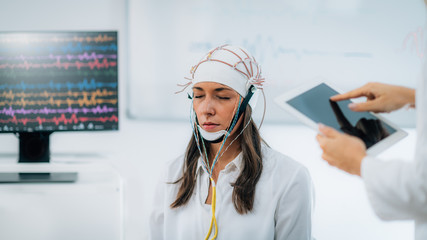
Mindfulness-based trainings typically combine focused-attention meditation with open-monitoring meditation that involves attending to the entire field of awareness. Little is known about how these different types of meditation uniquely contribute to emotional well-being.
Brown at al. [Psychophysiology] investigated the effects of these meditations, separately and combined, on measures of emotional reactivity and regulation.
The researchers randomly assigned 104 meditation-naïve predominantly female, Caucasian adults (average age = 40 years) with persistent mild-to-severe depression, anxiety, and/or stress to a focused-attention meditation training program, an open-monitoring meditation program, or a Mindfulness-Based Cognitive Therapy (MBCT) program that includes both types of meditation training.
All three programs were offered in formats that included 8 three-hour weekly groups and a full-day retreat. Participants were encouraged to engage in 45 minutes of daily home meditation practice. The focused-attention group used sensations such as the breath to anchor their meditations, while the open-monitoring group used mental noting to attend to the full range of sensory, cognitive, and emotional experiences.
Participants completed baseline and post-training electroencephalographic (EEG) measures of emotional reactivity and regulation. They were presented with a series of computerized positive, negative, and neutral images.
For the first 4 seconds of each image presentation, participants simply looked at the image allowing emotional reactions to arise. During the following 10 seconds they employed the meditative strategy they had been taught to regulate their emotional reactions to the picture—either breathing or mental noting. Participants also rated their mood after each viewing.
An EEG recorded any frontal lobe alpha wave asymmetry in response to the images. Greater left > right frontal alpha wave activity is associated with an approach response to stimuli, while greater right > left frontal alpha wave activity is associated with an avoidance response. Increased left > right activity reflects a decrease in negative emotional responsiveness to a stimulus.
Over the course of training, the MBCT and focused-attention groups showed significantly greater increased leftward shifts in alpha wave asymmetry compared to the open-monitoring group. This was true for both the emotional reactivity and the emotional regulation phases of EEG recording.
All three groups reported improved self-reported mood while viewing negative images from baseline to post-training with open-monitoring (d=0.63) and focused-attention groups (d=0.54) showing larger mood improvements than the MBCT group (d=0.21).
The study shows greater shifts in frontal lobe alpha wave asymmetry for focused-attention and MBCT training, but greater improvement in self-reported mood for open-monitoring training. It is not clear why these EEG and self-report results diverge. The study is limited by the lack of a non-meditation control group.
Reference:
Brown, K. W., Berry, D., Eichel, K., Beloborodova, P., Rahrig, H., Britton, W. B. (2022). Comparing impacts of meditation training in focused attention, open monitoring, and mindfulness-based cognitive therapy on emotion reactivity and regulation: Neural and subjective evidence from a dismantling study. Psychophysiology.
Link to study